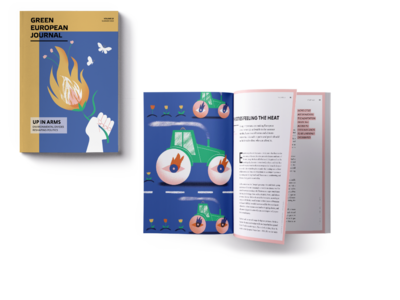The mad rush for precious minerals is sowing seeds of conflict. In Ghana, this conflict is unfolding around the country’s biggest resource: gold.
Galamsey is the popularised term for the “gathering and selling” of precious minerals by locals in Ghana. The use of small-scale, artisanal mining practices in gold-rich districts in Ghana date as far back as 2000 years. After encountering the budding trade and abundance of gold on these shores of the Gulf of Guinea in the 17th century, European colonists named today’s Ghana the Gold Coast.
True to the symbolism of the yellow in its post-independence flag, gold mining and export is a key component of the country’s resources and ambitions. Gold is Ghana’s number one export; the country is the leading producer in Africa as well as the 11th largest producer globally. According to the West Africa branch of the think tank Good Governance Africa, small-scale mining constitutes 30 per cent of the country’s total gold export and represents a significant source of revenue for people and government.
However, as the sector has boomed, galamsey has become synonymous with illegal industrial mining that leaves destruction in its wake. The activities of galamseyers across all the 10 known mining districts in Ghana release toxic materials into rivers, and destroy protected forests and farms including cocoa farms, which are Ghana’s third biggest source of revenue. Pollution from mines has turned the blue River Pra, a major source of water supply for communities in three regions, yellow. Since 2013, accidents such as cave-ins at unregulated sites have led to the deaths of hundreds. Studies have found that illegal miners leave sprawling wastelands – including open pits, waste piles and flood terrains – in their trail.
These pressures have only increased as gold has gained importance internationally and in the government’s development agenda, bringing new foreign and national players onto the scene. In 2022, global central banks purchased the highest quantities of gold not seen since the 1950s. Gold is also used in the circuitry of smartphones and is a critical metal to the global digital transition. Since the early 2000s, Chinese miners have entered the trade illegally in their thousands, often with wealthy backers and wielding weapons. The arrival of Chinese firms has rapidly changed the sector. Not only are excavators and heavy metals now commonly used, but excavation in some areas also takes mere weeks instead of years.
On the campaign trail, President Nana Akufo-Addo promised a “Ghana beyond aid”. Stuck in a downward economic spiral while strapped for cash and under the crushing weight of debt, his administration is turning to natural resources. In the latest development, the government’s stake in mining ventures was put on the financial markets while the administration brokered a gold-for-oil deal. Although these deals provide legal routes for scaling mining in the country and for foreign miners, illegal small-scale mining has only grown, and the government continues to make undisclosed losses in revenue and exports. Armed miners fiercely defend their mines and even plot hostile takeovers of rival mines.
For a country renowned for its stability in a turbulent region, this increasing militarisation and unprecedented destruction has been unsettling and caused public uproar. Galamsey is now one of the most talked about issues in the country, framed as an environmental, economic, and security disaster, and uniting citizens in their call for urgent and effective government action.
So far, the Ghanaian government has struggled to handle the problem and some of its actions have only made matters worse. While small-scale mining generally is not illegal, unlicensed surface mining and the use of unapproved methods of exploiting gold is. A 1980 law also bans foreigners from working in the small-scale mining industry. In a renewed effort to enforce these rules, the government deported 4500 Chinese nationals in 2013 and declared “war on galamsey” in 2017. A militarised response was abandoned in 2020 after it proved highly ineffective and generated allegations of excessive use of force, extortion, and corruption.
Ghana is a member of anti-graft body Extractive Industries Transparency Initiative, but Good Governance Africa’s analysis shows that corruption remains a big stumbling block in reining in galamsey. Prominent individuals and entities engaged in galamsey use their undisclosed profits to influence officials mandated to scrutinise the sector. Some high-ranking officials responsible for the sector are allegedly complicit in galamsey activities. Those looking to mine legally complain that the government’s permit system is bureaucratic, confused, and marked by partisan political competition, which makes shortcuts attractive.
The courts have also stepped in. According to Attorney General Godfred Dame, over 700 persons of various nationalities are standing trial for their involvement in galamsey. He argues that the court’s slow prosecution process and continuous grant of bail have damaged accountability and the deterrence message to galamseyers.
While public attention on galamsey is spurring a political discourse of blame, communities in mining districts are left to face multiple stressors: poverty, shrinking clean water supply, pollution, ill health, violence and impunity, a growing appetite for gold, and a warming climate chipping away at resources and livelihoods. This new phase of fragility and environmental conflict is alarming. The story of small-scale gold mining doesn’t bode well for communities in other resource-rich areas where there is heightened interest in extraction. Ghana’s hard-won political stability demands its leaders find a sustainable way out of the impasse and reconcile development ambitions with the right to a healthy and safe environment.

